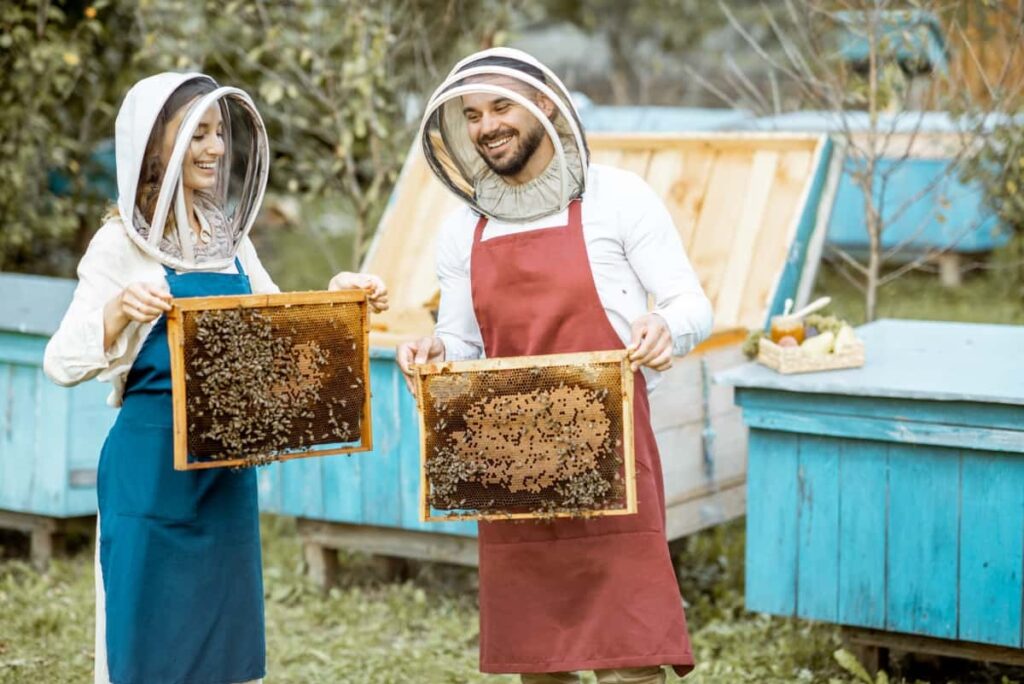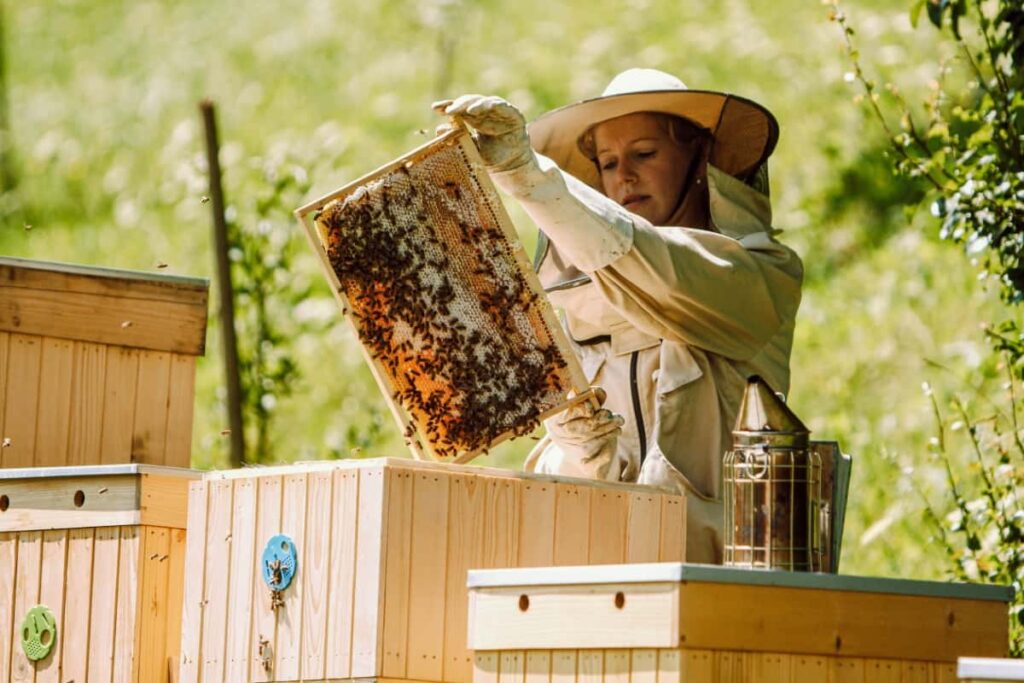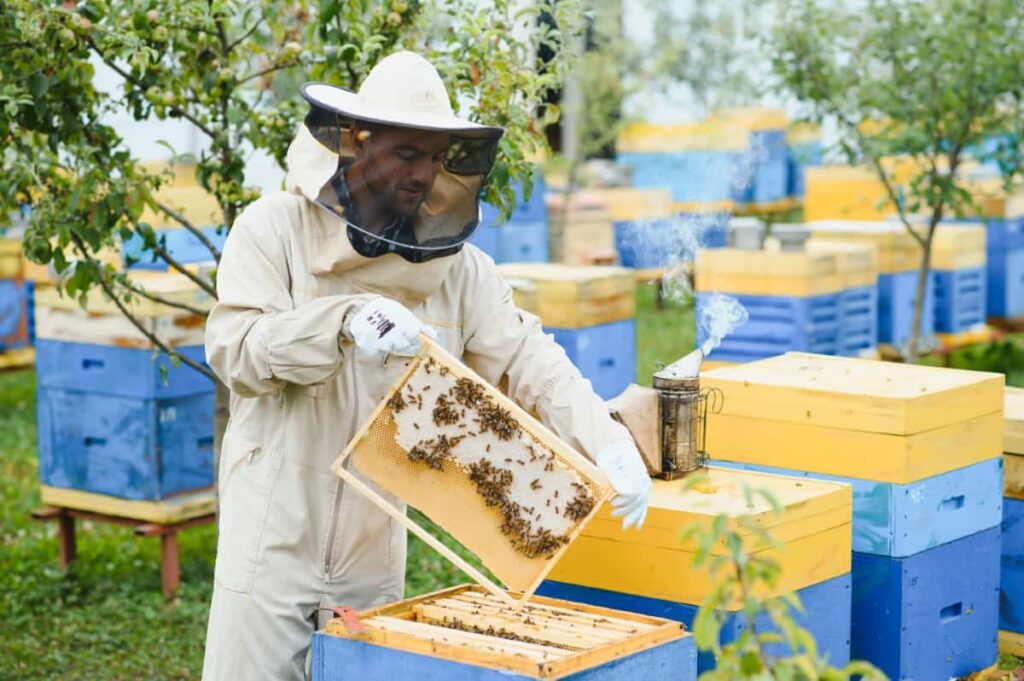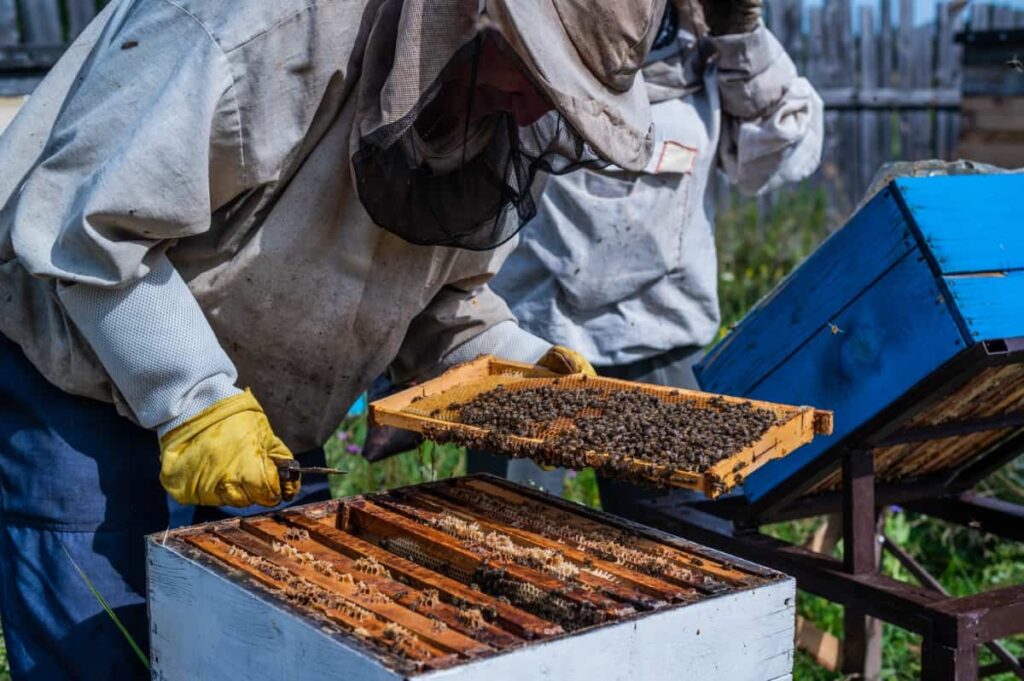Italian Honey Bees (Apis mellifera ligustica) are renowned for their gentle nature, high productivity, and adaptability, making them a favorite among beekeepers worldwide. Originating from Italy, these bees have been selectively bred for centuries to exhibit desirable traits for honey production and pollination.
History and Origin of Italian Honey Bees
Italian Honey Bees trace their origins back to Liguria, Italy, where they were first documented in the 19th century. The breed gained popularity due to its remarkable honey production and calm demeanor, which facilitated easier management for beekeepers. Beekeeping with Italian Bees was subsequently introduced to various regions globally, becoming one of the most widely utilized honey bee breeds in apiculture.

Italian Honey Bee
Italian Bee Characteristics
Physical Traits
Italian Honey Bees typically display distinctive golden-yellow coloration with banding patterns. They have relatively long tongues, enabling them to access nectar from deep flowers efficiently. Additionally, their relatively large size contributes to their efficiency in foraging and honey production.
Behavioral Traits
Italian Honey Bees are well known for their docile temperament, making them ideal for beekeepers, especially beginners. They exhibit less defensive behavior compared to other honey bee breeds, reducing the risk of stings during hive inspections or honey harvesting. Furthermore, they are prolific foragers, actively collecting nectar and pollen, contributing to robust hive populations and high honey yields.
Advantages of Italian Honey Bees for Beekeeping
High Honey Production
Italian Honey Bees are renowned for their exceptional honey production capabilities. Their prolific foraging behavior and efficient use of resources result in abundant nectar collection, leading to substantial honey yields. This characteristic makes them highly desirable for commercial beekeeping operations aiming to maximize honey production and profitability.
Gentleness and Manageability
One of the most notable Italian Honey Bees advantages is their gentle temperament and manageability. They exhibit less defensive behavior compared to other bee breeds, reducing the risk of stings and making hive inspections and maintenance tasks more manageable for beekeepers. Their calm demeanor also facilitates easier handling, making them suitable for beekeepers of all experience levels.
Breeding and Queen Rearing of Italian Honey Bees
Selecting Breeding Stock
For Italian Honey bee breeding, beekeepers should prioritize individuals with desirable traits such as high honey production, gentleness, disease resistance, and overwintering ability. This involves careful assessment of the colony’s performance, behavior, and health. Beekeepers may utilize methods such as instrumental insemination or natural mating in isolated mating yards to maintain and improve these traits within the breeding population.
Techniques for Queen Rearing
Queen rearing Italian Bees involve the controlled production of new queens to replace aging or underperforming queens in honey bee colonies. Techniques for queen rearing with Italian Honey Bees include grafting, where young larvae are transferred to queen cups, or utilizing queen cells produced by the colony itself. These methods require careful timing and management to ensure the successful development and mating of new queens, contributing to the vitality and productivity of honey production in Italian bee colonies.
In case you missed it: Greenhouse Beekeeping Startup Guide: Design, Techniques, Advantages, and Disadvantages

Hive Management for Italian Honey Bees
Seasonal Hive Management for Italian Honey Bees
Maintain optimal hive conditions through regular inspections, focusing on brood health, honey storage, and pest control. In spring, stimulate colony growth by providing ample space and supplemental feeding. Summer warrants vigilant mite monitoring and disease management. Fall preparation includes reducing hive size, insulating for winter, and treating for pests.
Preventing Swarming in Italian Honey Bee Colonies
Mitigate swarming by providing sufficient room for colony expansion, ensuring queen vitality through regular replacement if necessary, and conducting swarm inspections. Utilize swarm prevention techniques such as checkerboarding and split hives to disrupt swarm impulse. Monitor hive congestion and manage colony population to deter swarming tendencies.
Pest and Disease Resistance in Italian Honey Bees
Common Pests and Diseases
Italian honey bees, like any other bee species, are susceptible to various pests and diseases. Common pests include varroa mites, small hive beetles, and wax moths. Diseases such as American foulbrood, European foulbrood, and Nosema can also affect their colonies, potentially leading to significant losses if left unchecked.
Strategies for Enhancing Disease Resistance
For Italian bee pest control and to enhance disease resistance in Italian honey bee colonies, beekeepers employ various strategies. These may include regular monitoring for pests and diseases, practicing good hive management techniques, such as proper sanitation and ventilation, promoting genetic diversity through selective breeding programs, and implementing integrated pest management strategies, which may involve the use of organic treatments or essential oils to control pests and diseases while reducing harm to the bees and the environment and increase Italian bee disease resistance.
Italian Honey Bees Nutrition and Feeding
Nutritional Requirements
Italian honey bees, like all bee species, require a balanced diet to thrive. They primarily need carbohydrates from nectar for energy and pollen for protein, vitamins, and minerals. Additionally, water is crucial for hive temperature regulation and metabolism. Adequate foraging grounds with diverse floral sources are essential to fulfill these needs.
Supplemental Feeding Practices
Supplemental feeding becomes necessary during periods of nectar dearth or environmental stress. Common supplements include sugar syrup, pollen patties, and protein supplements. Care must be taken to mimic natural ratios and avoid overfeeding, which could lead to hive issues such as dysentery or excess moisture. Monitoring hive conditions and adjusting feeding practices accordingly is vital for healthy Italian bee colony management.
In case you missed it: Honeybee Farming Operations Management: Month-Wise Beekeeping Maintenance for Better Profits

Italian Honey Bees in Pollination Services
Role in Agriculture and the Environment
Italian honey bees play a vital role in agriculture by pollinating various crops, including fruits, vegetables, and nuts. Their contribution is essential for crop yield and quality, benefiting both farmers and consumers. Moreover, Italian bees for pollination extend beyond agriculture, supporting the biodiversity and health of natural ecosystems.
Maximizing Pollination Efficiency
To maximize pollination efficiency, proper hive management and placement are crucial. Providing sufficient forage and minimizing exposure to pesticides are essential for maintaining healthy bee populations. Additionally, diversifying floral resources and incorporating native plant species can enhance pollination outcomes. Collaborative efforts between beekeepers, farmers, and researchers are essential for optimizing the contribution of Italian honey bees to pollination services.
Harvesting Honey from Italian Honey Bees
Best Practices for Honey Extraction
- Timing: Harvest honey when frames are capped (~80% capped cells).
- Tools: For honey harvesting Italian bees, use a bee smoker to calm bees, a bee brush to remove them gently, and a honey extractor.
- Extraction: Uncap frames using a hot knife, place them in the extractor and spin to release honey.
- Straining: Filter honey to remove impurities using a fine mesh or cheesecloth.
- Safety: Wear protective gear to prevent stings and ensure cleanliness to maintain honey quality.
Processing and Storing Honey
- Settling: Allow honey to settle in a clean container for a day to remove air bubbles.
- Packaging: Store in clean, dry, airtight containers away from sunlight and heat.
- Labeling: Label with harvest date and type of honey.
- Storage: Keep honey in a cool, dark place to prevent crystallization and maintain flavor and quality.
In case you missed it: 17 Honeyberry Varieties: Best Cultivars to Grow in your Garden

Conclusion
Italian honey bees are an excellent choice for beekeepers looking to establish productive and manageable colonies. By understanding their characteristics, providing proper care, and implementing effective management practices, beekeepers can enjoy the many rewards that come from working with these remarkable insects.
- Irrigation and Water Management in Pineapple Farming
- Blossom to Harvest: Mastering Flowering and Pollination in Papaya Farming
- Pig Fattening Essentials: From Selection to Sale for Beginners
- Raising Wagyu Cattle: A Complete Guide for Premium Beef Production
- Soil Types and Their Water Holding Capacity
- Optimizing Irrigation Schedules for Coconut Groves for Enhanced Yield
- Espresso Your Garden: Coffee Grounds for Healthier Acid-Loving Plants
- The Best Soil Mix for Snake Plants: How to Mix Your Own Snake Plant Soil
- Green Thumb Success: Expert Tips for Cultivating Greenhouse Beans All Year Round
